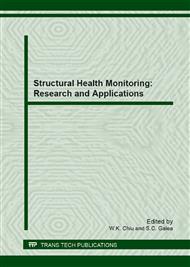[1]
Staszewski, W.J., B.C. Lee, and R. Traynor, Fatigue crack detection in metallic structures with Lamb waves and 3D laser vibrometry. Measurement Science & Technology, 2007. 18(3): pp.727-739.
DOI: 10.1088/0957-0233/18/3/024
Google Scholar
[2]
Alleyne, D.N. and P. Cawley, The Interaction of Lamb Waves with Defects. Ieee Transactions on Ultrasonics Ferroelectrics and Frequency Control, 1992. 39(3): pp.381-397.
DOI: 10.1109/58.143172
Google Scholar
[3]
Ryles, M., et al., Comparative study of nonlinear acoustic and Lamb wave techniques for fatigue crack detection in metallic structures. Fatigue & Fracture of Engineering Materials & Structures, 2008. 31(8): pp.674-683.
DOI: 10.1111/j.1460-2695.2008.01253.x
Google Scholar
[4]
Ong, W.H. and W.K. Chiu, Damage Quantification in Plates Using Lamb Waves, in Australasian Congress on Applied Mechanics. 2010: Perth, Australia.
Google Scholar
[5]
Doherty, C. and W.K. Chiu, Scattering of ultrasonic-guided waves for health monitoring of fuel weep holes. Structural Health Monitoring, 2011.
DOI: 10.1177/1475921710395814
Google Scholar
[6]
Baker, A., Structural Health Monitoring of a Bonded Composite Patch Repair on a Fatigue-Cracked F-111C Wing. 2008, Defence Science and Technology Organisation: Melbourne.
Google Scholar
[7]
Baker, A., N. Rajic, and C. Davis, Towards a practical structural health monitoring technology for patched cracks in aircraft structure. Composites Part a-Applied Science and Manufacturing, 2009. 40(9): pp.1340-1352.
DOI: 10.1016/j.compositesa.2008.09.015
Google Scholar
[8]
Wong, C.K.W., et al., Can stress waves be used for monitoring sub-surface defects in repaired structures. Composite Structures, 2006. 76(3): pp.199-208.
DOI: 10.1016/j.compstruct.2006.06.035
Google Scholar
[9]
Teo, Y.H., et al., Optimal placement of sensors for sub-surface fatigue crack monitoring. Theoretical and Applied Fracture Mechanics, 2009. 52(1): pp.40-49.
DOI: 10.1016/j.tafmec.2009.06.007
Google Scholar
[10]
Chiu, W.K., T. Tian, and F.K. Chang, The effects of structural variations on the health monitoring of composite structures. Composite Structures, 2009. 87(2): pp.121-140.
DOI: 10.1016/j.compstruct.2008.05.024
Google Scholar
[11]
Coelho, K. and S.B. Kim. Optimal sensor placement for active guided wave interrogation of complex metallic components. in Sensors and Smart Structures Technologies for Civil, Mechanical, and Aerospace Systems 2011. 2011. San Diego, California, USA SPIE.
DOI: 10.1117/12.880288
Google Scholar
[12]
Kessler, S.S., S.M. Spearing, and C. Soutis, Damage detection in composite materials using Lamb wave methods. Smart Materials & Structures, 2002. 11(2): pp.269-278.
DOI: 10.1088/0964-1726/11/2/310
Google Scholar
[13]
Ong, W.H. and W.K. Chiu, An Optical Approach to Guiding Lamb Waves in Plates For Design For Structural Health Monitoring, in Asia Pacific Workshop on Structural Health Monitoring. 2010: Tokyo, Japan.
Google Scholar
[14]
Baker, A.A., et al., Repair substantiation for a bonded composite repair to F111 lower wing skin. Applied Composite Materials, 1999. 6(4): pp.251-267.
Google Scholar
[15]
Su, Z. and L. Ye, Identification of damage using Lamb waves from fundamentals to applications, in Lecture Notes in Applied and Computational Mechanics,. 2009, Springer-Verlag: [Berlin].
DOI: 10.1007/978-1-84882-784-4_2
Google Scholar
[16]
Cho, K., Estimation of ultrasonic guided wave mode conversion in a plate with thickness variation. Ieee Transactions on Ultrasonics Ferroelectrics and Frequency Control, 2000. 47(3): pp.591-603.
DOI: 10.1109/58.842046
Google Scholar


